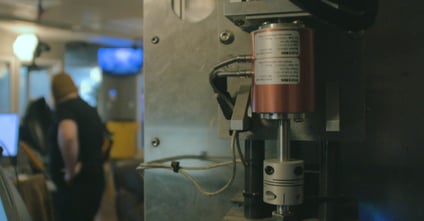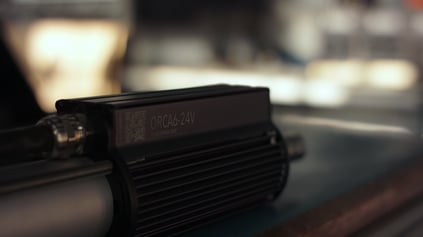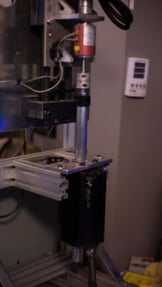- March 16, 2023
Measuring Force with an ORCA™ Series Smart Linear Motor
Introduction
 Load cells are the most commonly used type of force sensor. There are many types of load cells, however, all of them work on the same basic premise of converting mechanical force into electrical energy. Load cells can be found in applications that require high precision and accuracy.
Load cells are the most commonly used type of force sensor. There are many types of load cells, however, all of them work on the same basic premise of converting mechanical force into electrical energy. Load cells can be found in applications that require high precision and accuracy.
Hydraulic load cells are most suited to remote and dangerous applications due to their lack of electrical components while pneumatic load cells can be used in very sensitive environments such as clean rooms and food safe or medical environments. Both of these types of load cells require sources of fluid or gas to operate.
Pictured Above: A Load Cell
Strain gauge load cells are very common and operate by producing a voltage fluctuation when they are deformed. Typically, strain gauge load cells contain multiple strain gauges with some under tension and others under compression. This allows the sensor to read both directions of force while remaining at a balanced zero state when no forces are applied.
Piezoresistive load cells operate on the same principle as strain gauge load cells. However, piezoresistive load cells have a non-linear output voltage. Lastly, inductive load cells, reluctance load cells, and magnetostrictive load cells all operate by measuring changes in magnetic fields. Inductive and reluctant load cells read the displacement of a ferromagnetic core.
Magnetostrictive load cells measure the changes in magnetic fields as a ferromagnetic core is deformed. All variations of load cell provide high levels of precision and accuracy for their applications but can be entirely cost prohibitive in some cases. Additionally, regular calibration is required to ensure that the load cell is operating both accurately and reliably. Many load cells also have an unfortunate tradeoff between the total range of acceptable force readings and the resolution of said force readings. The delicacy of some units can completely preclude their usefulness entirely.
Force Sensing and ORCA Series Motors
The use of Iris Dynamics’ ORCA Series linear motors removes the requirement for separate load cells from many applications. The ORCA Series motor could be most closely compared to an inductive load cell with a few key differences.
 The first difference between an inductive load cell and an ORCA Series motor is that the ORCA Series motor is compliant. This means that should the applied force exceed the maximum force that the sensor can read or mechanically handle, the shaft of the ORCA Series motor simply moves linearly with the force in a compliant manner meaning nothing can be mechanically damaged should the system be overloaded.
The first difference between an inductive load cell and an ORCA Series motor is that the ORCA Series motor is compliant. This means that should the applied force exceed the maximum force that the sensor can read or mechanically handle, the shaft of the ORCA Series motor simply moves linearly with the force in a compliant manner meaning nothing can be mechanically damaged should the system be overloaded.
Additionally, there is no theoretical maximum travel limiting the ORCA Series motor. The ORCA Series motor also uses a feedforward system rather than a feedback system. This means that the ORCA Series motors arrive at a new control signal every time the position is measured. Whereas systems with load cells arrive at a new control signal only after the previous control signal has propagated through the system. This includes measurement and communication latency. The difference gives ORCA Series motors the edge in performance and control bandwidth.
The ORCA Series motors are robust to dust and debris allowing them to work in both high intensity environments such as heavy industrial environments, as well as delicate deployments and clean rooms.
 Applications that require extremely high levels of accuracy and precision may require the use of a load cell in addition to an ORCA Series linear motor. Traditionally, to measure or control forces on a motor, load cell is attached between the motor and the end effector. That load cell would be connected to an amplifier and that amplifier would connect to the motor controller or some other data logging device.
Applications that require extremely high levels of accuracy and precision may require the use of a load cell in addition to an ORCA Series linear motor. Traditionally, to measure or control forces on a motor, load cell is attached between the motor and the end effector. That load cell would be connected to an amplifier and that amplifier would connect to the motor controller or some other data logging device.
If the application needs sub-milligram accuracy this is likely best practice. However if the application only needs a few grams of accuracy then the integrated ORCA Series motor solution removes a significant amount of complexity.
Additionally, ORCA Series motors inherent force sensing in addition to compliance helps protect sensitive equipment like the load cell.
An ORCASeries Motor on a Test Platform
Using an ORCA Series Motor as a Scale
